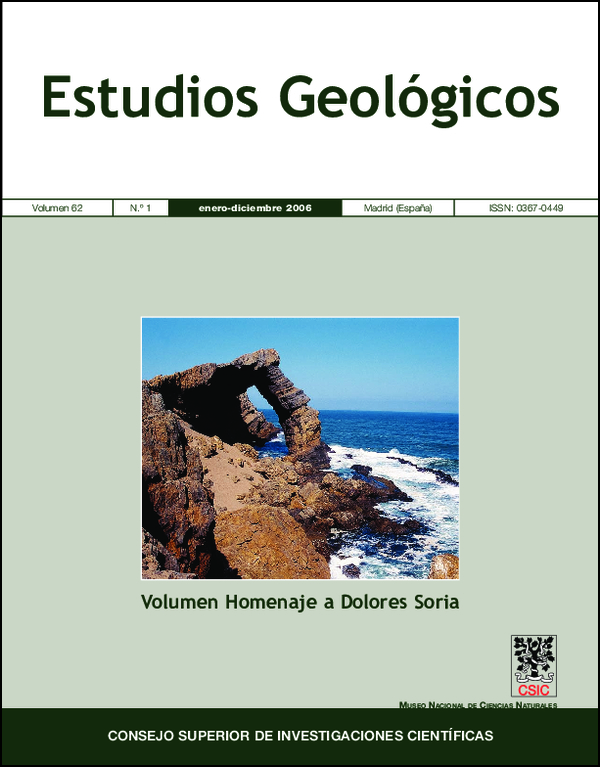Cenogramas, análisis bioclimático y muestreo en faunas de mamíferos: implicaciones para la aplicación de métodos de análisis paleoecológico
DOI:
https://doi.org/10.3989/egeol.0662113Keywords:
bioclimatic analysis, cenograms, mammalian communities, methodology, paleoclimatology, paleoecology, ecological redundanceAbstract
In this work we analyzed the problems derived from the potential species loss associated to the taphonomic processes occurring in fossil sites. We seek to resolve the possible utility of cenograms and bioclimatic analysis as methodologies applicable in Paleoecology. Supposedly, if species are deleted in a community, significant changes in its structure might appear, which would make these paleoecological techniques dysfunctional. The analysis has been carried out with the data of two modern mammalian communities, Barrow (Alaska) and Jaipur (India), on which we have deleted species randomly. Our results have allowed us to conclude that these methodologies are useful in Paleoecology, since they are functional with a satisfactory level of confidence, as long as the species loss is not excessively elevated (for communities with 20-40% of the original species).
Downloads
References
Andrews, P. (1995). Mammals as palaeoecological indicators. Acta Zool. Cracoviensia, 38: 59-72.
Corbet, G. B. y Hill, J. E. (1992). The Mammals of the Indomalayan Region: a SystematicReview. Oxford University Press, Oxford, 488 págs.
Fonseca, C. R. y Ganade, G. (2001). Species functional redundancy, random extinctions and the stability of ecosystems. J. Ecol., 89: 118-125. doi:10.1046/j.1365-2745.2001.00528.x
Fortelius, M., Eronen, J., Jernvall, J., Liu, L., Pushkina, D., Rinne, J., Tesakov, A., Vislobokova, I., Zhang, Z. y Zhou, L. (2002). Fossil mammals resolve regional patterns of Eurasian climate change over 20 million years. Evol. Ecol. Res., 4: 1005-1016.
Gross, K. y Cardinale, B. J. (2005). The functional consecuences of random vs. ordered species extinctions. Ecol. Letters, 8: 409-418. doi:10.1111/j.1461-0248.2005.00733.x
Hall, E. R. (1981). The Mammals of North America, Vol. I-II, John Wiley y Sons, New York, 1.265 págs.
Hernández Fernández, M. (2001). Bioclimatic discriminant capacity of terrestrial mammal faunas. Global Ecol. Biogeogr., 10: 113-128.
Hernández Fernández, M., Alberdi, M. T., Azanza, B., Montoya, P., Morales, J., Nieto, M. y Peláez-Campomanes, P. (2006): Identification problems of arid environments in the Neogene-Quaternary mammal record of Spain. J. Arid Environ., 66: 585-608. doi:10.1016/j.jaridenv.2006.01.013
Hernández Fernández, M. y Peláez-Campomanes, P. (2003). The bioclimatic model: a method of palaeoclimatic qualitative inference based on mammal associations. Global Ecol. Biogeogr., 12: 507-517. doi:10.1046/j.1466-822X.2003.00057.x
Hernández Fernández, M. y Peláez-Campomanes, P. (2005). Quantitative palaeoclimatic inference based on terrestrial mammal faunas. Global Ecol. Biogeogr., 14: 39-56. doi:10.1111/j.1466-822X.2004.00125.x
Hooper, D. U., Chapin, F. S., Ewel J. J., Hector A., Inchausti P., Lavorel S., Lawton J. H., Lodge D. M., Loreau M., Naeem S., Schmid B., Seta LA H., Symstad A. J., Vandermeer J. y Wardle D. A. (2005). Effects of biodiversity on ecosystem functioning: a consensus of current knowledge. ESA Report. Ecological Monographs, 75: 3-35. doi:10.1890/04-0922
Larsen, T. H., Williams, N. M. y Kremen, C. (2005). Extinction order and altered community structure rapidly disrupt ecosystem functioning. Ecol. Letters, 8: 538-547. doi:10.1111/j.1461-0248.2005.00749.x
Legendre, S. (1986). Analysis of mammalian communities from the Late Eocene and Oligocene of southern France. Palaeovertebrata, 16: 191-212.
Lyons, K. G., Brigham, C. A., Traut, B. H. y Schwartz, M. W. (2005). Rare species and ecosystem functioning. Conservation Biol., 19: 1019-1024. doi:10.1111/j.1523-1739.2005.00106.x
Manly, B. F. J. (1997). Randomization, Bootstrap and Monte Carlo methods in Biology. 2ª edición. Chapman and Hall, London, 399 págs.
Mares, A. M. y Willig, M. R. (1994). Infering biome associations of recent mammals from samples of temperate and tropical faunas: paleoecological considerations. Historical Biol., 8: 31-48.
Margalef R., (1991). Teoría de los sistemas ecológicos. Universitat de Barcelona, Barcelona, 290 págs.
Martínez, J. G. (2002). La evolución y la conservación de la biodiversidad. En: Evolución: La Base de la Biología (M. Soler, edit.). Proyecto Sur ediciones, 407-416.
Micheli, F. y Halpern, B. S. (2005). Low functional redundancy in coastal marine assemblages. Ecol. Letters, 8: 391-400. doi:10.1111/j.1461-0248.2005.00731.x
Naeem, S. (1998). Species redundancy and ecosystem reliability. Conservation Biol., 12: 39-45. doi:10.1046/j.1523-1739.1998.96379.x
Nieto, M. & Rodríguez, J. (2003). Inferencia paleoecológica en mamíferos cenozoicos: limitaciones metodológicas. Coloq. Paleontol., Vol. Ext. 1: 459-474.
Quince, C., Higgs, P. G. y McKane, A. J. (2005). Deleting species from model food webs. Oikos, 110: 283-296. doi:10.1111/j.0030-1299.2005.13493.x
Rodríguez, J. (1999). Use of cenograms in mammalian palaeoecology. A critical review. Lethaia, 32: 331-347.
Roger, J. (1980). Paleoecología. Paraninfo, Madrid, 202 págs.
Schwartz M. W., Brigham, C. A., Hoeksema, J. D., Lyons K. G., Mills M. H. y Van Mantgem, P. J. (2000). Linking biodiversity to ecosystem function: implications for conservation ecology. Oecologia, 122: 297-305. doi:10.1007/s004420050035
Sinclair, A. R. E. (2003). The role of mammals as ecosystem landscapers. Alces, 39: 161-176.
Valverde, J. A. (1964). Estructura de una comunidad de vertebrados terrestres. Monografías de la Estación Biológica de Doñana, 1: 1-129.
Vilá, M. (1998). Efectos de la diversidad de especies en el funcionamiento de los ecosistemas. Orsis, 13: 105-117.
Tokeshi, M. (1999). Species coexistence. Ecological and evolutionary perspectives. Blackwell Science, 48 págs.
Walker, B. H. (1992). Biodiversity and ecological redundancy. Conservation Biol., 6: 18-23. doi:10.1046/j.1523-1739.1992.610018.x
Walter, H. (1970). Vegetationszonen und Klima. Eugen Ulmer, Stuttgart, 245 págs.
Wellnitz, T. y LeRoy Poff, N. (2001). Functional redundancy in heterogeneous enviroments: implications for conservation. Ecol. Letters, 4: 177-179. doi:10.1046/j.1461-0248.2001.00221.x
Downloads
Published
How to Cite
Issue
Section
License
Copyright (c) 2006 Consejo Superior de Investigaciones Científicas (CSIC)

This work is licensed under a Creative Commons Attribution 4.0 International License.
© CSIC. Manuscripts published in both the print and online versions of this journal are the property of the Consejo Superior de Investigaciones Científicas, and quoting this source is a requirement for any partial or full reproduction.
All contents of this electronic edition, except where otherwise noted, are distributed under a Creative Commons Attribution 4.0 International (CC BY 4.0) licence. You may read the basic information and the legal text of the licence. The indication of the CC BY 4.0 licence must be expressly stated in this way when necessary.
Self-archiving in repositories, personal webpages or similar, of any version other than the final version of the work produced by the publisher, is not allowed.















